Abstract
Initially, pristine polymers were used to develop corrosion-resistant coatings. Later, the trend shifted to the use of polymeric nanocomposites in anti-corrosion materials. In this regard, graphene has been identified as an important corrosion-resistant nanomaterial. Consequently, polymer/graphene nanocomposites have been applied for erosion protection applications. Among polymers, conducting polymers (polyaniline, polypyrrole, polythiophene, etc.) and nonconducting polymers (epoxy, poly(methyl methacrylate), etc.) have been used as matrices for anticorrosion graphene nanocomposites. The corrosion-resistant polymer/graphene nanocomposites have found several important applications in biomedical fields such as biocompatible materials, biodegradable materials, bioimplants, tissue engineering, and drug delivery. The biomedical performance of the nanomaterials depends on the graphene dispersion and interaction with the polymers and living systems. Future research on the anti-corrosion polymer/graphene nanocomposite is desirable to perceive further advanced applications in the biomedical arenas.
1. Introduction
Corrosion or erosion is a serious technological issue in metal-related materials and industries [1]. To deal with the corrosion issue, several corrosion-resistant coatings, inhibitors, additives, etc. have been developed [2,3,4]. Anticorrosion technologies are used to enhance the lifetime of metal-based parts and materials employed in various industries [5]. The corrosion resistance can be enhanced using carbon nanoparticles such as graphene, carbon nanotube, and carbon black [6]. Polymer/carbon nanocomposites possess superior anticorrosion features relative to neat polymers [7]. The performance of anticorrosion polymer/carbon nanocomposites depends on the nanofiller dispersion and compatibility with the polymer [8]. Graphene has been recognized as a unique nanomaterial with erosion-protective properties [9]. Polymers with graphene nanofiller have been applied to develop the anticorrosion coatings [10]. Conjugated and nonconjugated polymers have been employed to fabricate graphene-based nanocomposites. Graphene in polymers offers tortuous pathways to hinder the diffusion of corrosive species [11,12]. Such nanocomposites have been casted using various techniques such as solution casting, dip coating, spraying, spin coating, and printing [13,14,15]. Corrosion-resistant polymer/graphene nanocomposites have found wide-ranging potential in the biomedical fields [16]. The biomedical application of anticorrosion polymer/graphene nanomaterials relies on graphene’s better dispersion, interfacial interactions, and bio-miscibility properties. Hence, the biomedical fields explored include bioimplants, tissue engineering, and drug delivery. Parenthetically, the physical/chemical functionalization of graphene may further enhance the dispersion, interactions, anticorrosion, and biomedical properties of nanocomposites.
Hence, this review focuses on anticorrosion polymer/graphene nanocomposites, covering the essential design and property aspects. This article proposes a groundbreaking and innovative review on anticorrosion polymer/graphene nanomaterials for biomedical applications. The review is no doubt revolutionary in portraying practical advancements in the field of anticorrosion polymer/graphene nanocomposites. Graphene incorporated into polymeric nanocomposites can considerably augment the biomedical properties. The main objective of this manuscript is to create a comprehensive understanding of the physical properties and mechanisms behind the anticorrosion efficiency of graphene and polymer/graphene nanocomposites. Future efforts in the field of anticorrosion polymers/fullerenes are not possible before obtaining prior knowledge on existing studies on relevant biomedical nanocomposites.
2. Polymers in Corrosion Resistance
The corrosion process has been known to seriously damage the metal surface through chemical/electrochemical reactions, as a result of environmental changes [17]. During rusting, metal surfaces are bonded to chemical species such as nitrates, sulfides, and oxides, thus destroying their form. In this regard, several mechanisms have been suggested for metal protection [18]. Accordingly, corrosion has been identified as a serious issue for electronic, automotive, aircraft, and aerospace parts [19,20]. To prevent corrosion, metal parts can be coated with various materials to prevent the erosion process [21,22]. Polymer coatings have been applied for the erosion inhibition of mild steel [23]. Polymers with additives have also been used as corrosion inhibitors [24,25]. Polymer-based coatings have been used to prevent chemical reactions from occurring at the metal surface [26]. In this regard, conducting polymers have been employed as corrosion-resistant materials on metal surfaces [27]. Conjugated polymers such as polyaniline and polypyrrole have been utilized to protect the carbon steel and stainless-steel metallic surfaces [28,29,30]. Among nonconducting polymers, epoxy, poly(ethylene glycol), etc. have been used to develop anticorrosion coatings [31]. Table 1 shows few important corrosion-resistant polymers. Anticorrosion polymer coatings have revealed outstanding relevance for corrosion prevention [32].

Table 1.
Examples of polymers for corrosion defense.
3. Polymeric Nanocomposites for Corrosion Resistance
Polymeric nanocomposites usually consist of polymeric matrices reinforced with nanoparticle nanofillers [38]. The amalgamation of polymers and nanofillers may result in superior electrical, mechanical, thermal, flame-resistant, and anticorrosion features [39]. Consequently, polymeric nanocomposites have found surplus applications in technical arenas such as the aerospace/automotive, construction, energy devices, electronics, and biomedical fields [40]. Conjugated polymers have been studied as important matrices for corrosion protection [41,42]. Conjugated polymer-derived nanocomposites may offer fine erosion resistance and mechanical properties [43]. Numerous conducing polymers such as polyaniline, polypyrrole, and polythiophene have been applied for anticorrosion application [44]. Nonconducting polymers have also been used for corrosion resistance applications. For example, polytetrafluoroethylene filled with alumina nanoparticles was designed to enhance anticorrosion and scratch resistance [45,46]. Radhakrishnan and coworkers [47] fabricated an anticorrosion nanocomposite based on poly(vinyl butyral) and nano-TiO2 nanoparticles. The nanoparticle addition improved the corrosion resistance of the nanocomposite. Among conjugated polymers, polyaniline has been frequently used. Chen and coworkers [48] designed perfluorooctanoic acid-doped polyaniline nanoparticles for introduction into epoxy resin to develop an anticorrosion coating. Electrochemical impedance spectroscopy measurements in brine were used to evaluate the corrosion defense of polyaniline containing coatings on steel. Figure 1 shows the anticorrosion behavior and mechanism of the perfluorooctanoic acid-doped polyaniline/epoxy coating. Due to their structural design, nanocomposite coatings possess fine anticorrosion efficiency in corrosive media. In brine, the impedance modulus was found to be 6 × 108 Ω·cm2, showing good erosion resistance.
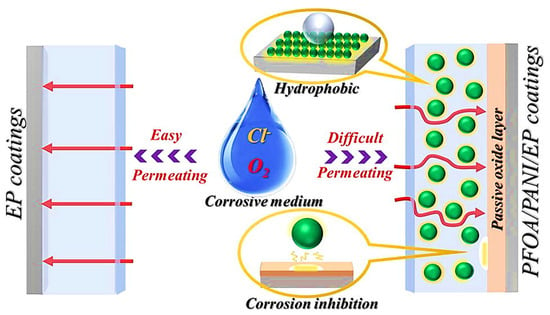
Figure 1.
Corrosion protection behavior of epoxy/polyaniline nanoparticle nanocomposite [48]. EP = epoxy; PFOA/PANI/EP = perfluorooctanoic acid-doped polyaniline in epoxy coating. Reproduced with permission from Elsevier.
4. Polymer/Graphene Nanocomposite in Corrosion-Resistant Coats
Corrosion-resistant materials/nanomaterials and coatings have been used to prevent metals from corrosion [49]. Various mechanisms have been proposed for the anticorrosion process such as the barrier effect and corrosion reserve processes [50]. Usually, an optimum amount of nanomaterial is desirable to form a protective layer on the metals [51]. Different nanofillers have been added to enhance the anticorrosion of base materials [52].
A single defect-free graphene layer (two dimensional nanosheet) showed outstanding defending performance against corrosion-causing molecules [53]. Graphene nanosheets have the ability to prevent corrosion-causing water or oxygen molecules from reaching the metal surface. Thus, graphene has been recommended as the thinnest known corrosion defense material [54]. Moreover, the electrical, mechanical, and tribology properties of graphene make it the most ideal anticorrosion coating.
Advanced polymer/graphene nanocomposites have been developed with light weight, inexpensiveness, and fine processability [55]. The nanofiller type controls the anti-rusting properties of metals through coatings [56]. Consequently, graphene has been considered as an important nanofillers in anticorrosion materials [57,58]. The performance and the mechanism of the corrosion resistance material depend on the graphene dispersion, coating thickness, porosity, and formation of circuitous diffusion paths for the corrosive agents [59,60,61]. Using epoxy resin and waterborne polyurethane, efficient anticorrosion coatings were developed in [62,63,64]. The epoxy/graphene-based nanomaterials revealed high toughness, adhesion, thermal stability, and chemical resistivity in addition to anticorrosion [65,66,67]. Similar to graphene, graphene oxide has also been used in anti-rusting epoxy coatings [68]. Graphene and graphene oxide may form a twisting diffusion path to hinder the permeation of corrosive molecules [69]. Zhang et al. [70] designed corrosion-resistant epoxy/graphene nanocomposite coatings. A five-layered epoxy coating was developed by the addition of graphene and alumina (Figure 2).
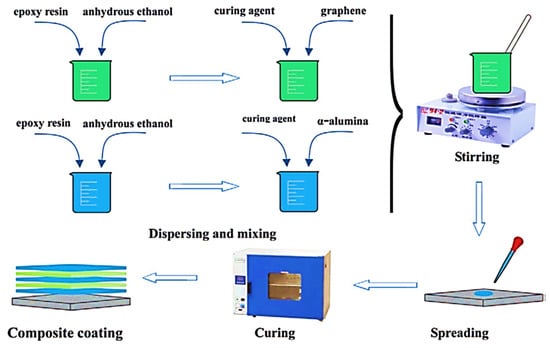
Figure 2.
Preparation process of corrosion-resistant multifunctional epoxy nanocomposite coating [70]. Reproduced with permission from Wiley.
For corrosion measurements, the samples were dipped in the 3.5% NaCl solution for 5 days. According to EIS measurements, the impedance of pure epoxy resin coating was 6.4 × 106 Ω·cm2 after 26 days (Figure 3). The inclusion of nanofillers decreased the impedance to 106 Ω·cm2, showing an improvement in the corrosion resistance of the nanocomposite. Figure 4 shows the anticorrosion mechanism of the multilayer nanocomposite coating. The barrier effect of the epoxy resin was enhanced severalfold using the graphene nanofiller. Qi et al. [36] proposed a poly(methyl methacrylate)/graphene oxide nanocomposite through atom transfer radical polymerization. The poly(methyl methacrylate)/graphene oxide nanocomposite was solution-processed with homogeneous thickness, permeation resistance to corrosive molecules, and improved physical properties [71].
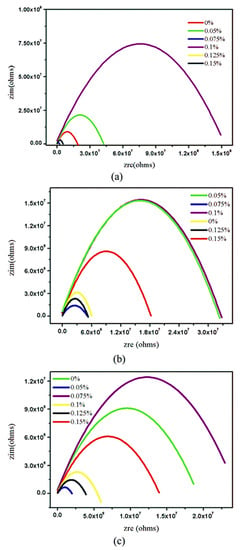
Figure 3.
EIS of coatings after immersion in 3.5% NaCl solution for different duration: (a) 5 days; (b) 16 days; (c) 26 days [70]. Reproduced with permission from Wiley.

Figure 4.
Schematic diagram of mechanism of action across five layers of coating [70]. Reproduced with permission from Wiley.
Among conjugated polymers [72], polyaniline has been applied in anti-rusting coats [73]. Kraljić and coworkers [74] industrialized polyaniline/graphene nanocomposite coatings. Figure 5 demonstrates the development of the polymer/graphene coating through the aniline monomer and in situ polymerization [75,76]. Graphene nanoparticle cause a fine dispersion and barrier effect, preventing the infiltration of water/oxygen molecules [77]. Sun et al. [78] formed an anticorrosion pernigraniline/graphene nanocomposite with fine scratch resistance features. The improved dispersion and interaction of graphene nanoparticles with polymers have been studied for nanocomposite coatings [79,80]. In this way, graphene has been combined with both conjugated and nonconjugated polymeric matrices for corrosion resistance properties.
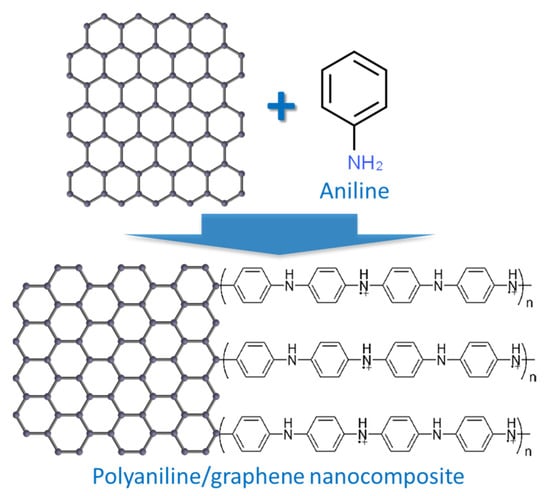
Figure 5.
Formation of polyaniline/graphene nanocomposite.
According to the electrochemical parameters of various anticorrosion polymer/graphene nanocomposites coated on mild steel under similar conditions, interesting results have been observed [69,81,82,83]. Among epoxy, polyaniline, polypyrrole, and polyurethane, the use of epoxy matrix with graphene was found to be ideal to attain high Ecorr, Icorr, and Rcorr parameters for anticorrosion application. The corrosion resistance efficiency of the coatings was dependent on factors such as graphene modification, polymer type, coating technique, and adhesion to substrate. It can be stated that epoxy offered a better matrix for graphene nanosheets to offer an enhanced barrier against the corrosive species.
5. Corrosion-Resistant Polymer/Graphene in Biomedical Applications
The use of polymers, in various commercial and industrial sectors, has been shifted to the development and employment of composite materials [84]. For high-performance materials, graphene has been used to reinforce polymeric nanocomposites for an improvement in strength, thermal resistance, thermal conductivity, electron transport, and biomedical application [85,86,87]. In the biomedical field, graphene-based materials have been used to enhance drug/gene delivery, cell proliferation, and tissue engineering [88,89,90]. Polymer/graphene nanocomposites have had a special impact in the biomedical field [90,91,92], such as in bioimplants, tissue engineering, and drug delivery [93,94,95,96].
5.1. In Bioimplants
Polymer graphene nanocomposites have been efficiently applied in bioimplants [97]. These nanomaterials have biodegradability and biocompatibility properties with essential functionalities to facilitate the development of efficient and affordable biomedical implants. Wen et al. [98] reported an anticorrosion hydroxyapatite/graphene oxide bio-nanocomposite. The nanocomposite coating was biodegradable and coated on a magnesium alloy to design the bioimplants. Li et al. [99] developed a biocompatible/biodegradable hydroxyapatite/graphene/graphene oxide nanocomposite coating using the hydrothermal method. The nanocomposite was used as the bone repair material. The nanocomposite coating enhanced the corrosion resistance of the magnesium alloy by approximately 28.53-fold with respect to the neat sample. This coating was used to enhance the anticorrosion of Mg alloys for clinical applications. Catt et al. [100] prepared a poly(3,4-ethylenedioxythiphene)/graphene oxide (PEDOT/GO) nanocomposite coating to form a corrosion-resistant biodegradable implant with magnesium metal. The coating was prepared through electro-polymerization on Mg metal. The Mg samples (coated/noncoated) were introduced to cultured neurons, where reduced toxicity was observed for the PEDOT/GO-coated sample. Moreover, the PEDOT/GO coating was biocompatible. Figure 6 shows the cracked plate-like morphology of the PEDOT/GO coating, along with the amorphous regions. Moreover, the EDX analysis of the cracked and amorphous morphology exhibited a high percentage of oxygen/phosphorus in cracked areas, relative to the amorphous regions. Figure 7 shows the percentage cytotoxicity of neurons (24 h exposure) in neuronal medium for the coated and noncoated samples. In 10% corrosion solution, the coated samples were seemingly less toxic compared with the noncoated samples.
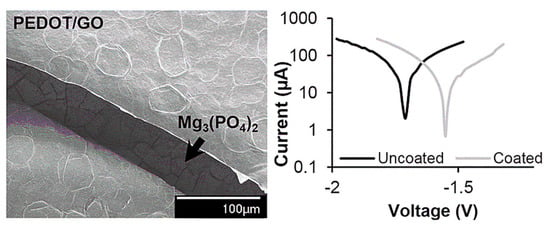
Figure 6.
Morphology and Tafel plots of poly(3,4-ethylenedioxythiphene)/graphene oxide (PEDOT/GO) nanocomposite for coated and noncoated samples [100]. Reproduced with permission from Elsevier.
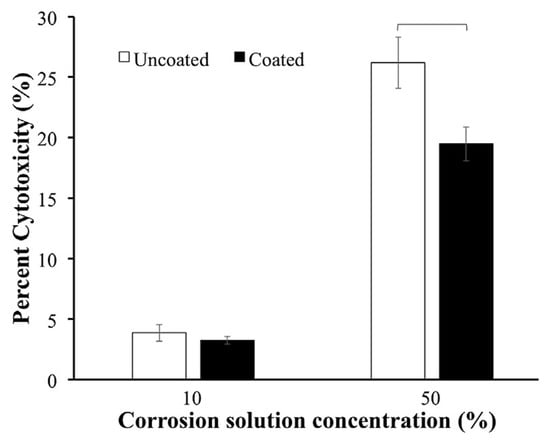
Figure 7.
Percentage cytotoxicity of neurons after 24 h exposure to medium (for coated/uncoated sample) corroded over 3 days, analyzed using live/dead staining [100]. Reproduced with permission from Elsevier.
5.2. Tissue Engineering
In tissue engineering applications, the worth of polymer/graphene nanocomposites has been recognized [101]. These nanomaterials have received considerable attention regarding their design, biocompatibility, and degradable properties for fabricating the desired biomedical scaffolds. The potential of anticorrosion polymer/graphene nanomaterials can further enhance the stability and efficiency of the engineered bio-tissues. However, further in vivo studies have been found desirable to validate the polymer/graphene nanocomposite scaffolds. Rikhari et al. [102] fabricated a polypyrrole (PPy) and polypyrrole/graphene oxide (PPy/GO) nanocomposite for tissue engineering. The nanocomposite was deposited on Ti metal using electro-polymerization. The corrosion protection efficiency of neat PPy and PPy/GO nanocomposite coatings, as well as their porosity, on Ti metal are depicted in Figure 8. The nanocomposite coating revealed a higher corrosion protection efficiency than the neat PPy coating. The porosity of the nanocomposite coating also displayed the same trend. Figure 9 shows the proliferation assay (MTT) for MG-63 cells on the surface of coated and noncoated Ti metal. A 7 day time interval was allowed for cell proliferation in the presence of PPy and the PPy/GO nanocomposite. The Ppy/GO nanocomposite facilitated the adhesion/proliferation of MG-63 cells without any cytotoxicity or corrosion phenomena. Therefore, the nanocomposite coatings were found to be effective. De Armentia et al. [103] prepared photopolymerizable acrylic resin/graphene oxide nanocomposites as anticorrosion materials for dentistry and tissue engineering applications. The graphene oxide content and number of layers in the nanocomposite determined the corrosion resistance performance of the nanomaterials. In summary, various polymer/graphene nanomaterials have been successfully designed and applied in anticorrosion biomedical tissue engineering applications.
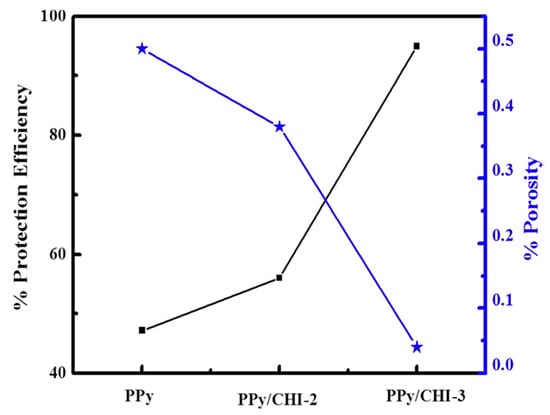
Figure 8.
Protection efficiency and porosity results for PPy and PPy/GO nanocomposite-coated Ti [102]. PPy = polypyrrole; Ppy/GO = polypyrrole/graphene oxide. Reproduced with permission from Springer.
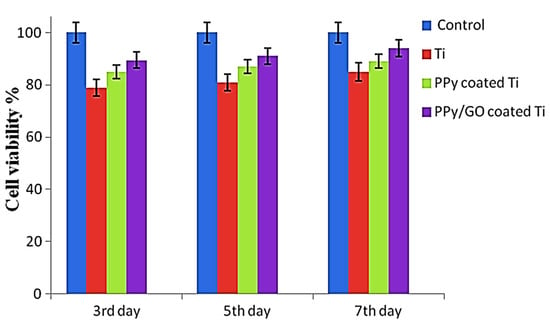
Figure 9.
In vitro MG-63 cell culture studies according to confocal images with MTT assay results for Ti, PPy coating, and PPy/GO composite-coated Ti [102]. MTT = cell proliferation assay. PPy/GO = polypyrrole/graphene oxide. Reproduced with permission from Springer.
5.3. Drug Delivery
In biomedicine applications such as drug transfer and tissue manufacturing, polymer/graphene nanomaterials have been effective [92]. Graphene and graphene-derived nanomaterials have been found promising for designing advanced drug delivery systems for a range of therapeutics. Studies have revealed observed that graphene/graphene oxide-based nanocomposites may cause dose-dependent toxic effects in living systems (cells of liver, kidney, lungs, etc.) [104]. For example, a low dose of 0.1 mg graphene nanocomposite was found to be nontoxic. At low graphene nanocomposite content, the material behaved as a biocompatible and miscible nanomaterial with living cells. However, increasing the dose loading to 0.25–0.4 mg produced serious toxic effects in the living cells. Therefore, the threshold level for the dose must be taken into the consideration, while using the graphene-based nanocomposites in drug delivery or tissue engineering applications.
6. Encounters and Conclusions
In this review, an all-inclusive evaluation of the design, features, and potential of anticorrosion polymer/graphene nanocomposite coatings was presented. These coatings unusually have a high surface area, inexpensiveness, light weight, conductivity, and corrosion resistance [105]. The worth of anticorrosion polymer/graphene nanocomposites in biomedical applications has been observed. Amongst nanocarbon nanoparticles, graphene nanofillers have gained special research attention [106,107]. For corrosion protection, graphene nanofillers have been successfully employed. Numerous mechanisms have been proposed for the anticorrosion properties of graphene-based nanomaterials [108]. In the biomedical field, efficient corrosion protection coatings have been developed using polymer/graphene nanocomposites [109].
Relative to other anticorrosion polymer/nanocarbon nanocomposites, polymer/graphene nanomaterials have been found advantageous [110]. Graphene has a nanosheet-like structure, relative to elongated nanotube or spherical nanocarbon nanoparticles [111]. Owing to the unique two-dimensional graphene nanostructure, graphene nanosheets upon dispersion offer a better barrier compared with carbon nanotube fillers in polymeric matrices [112]. These efficient barrier properties have been observed through the formation of tortuous pathways (using nanosheets) for the restrictive diffusion of corrosive species or gases. Higher graphene nanofiller loading may even improve the resistance to corrosive molecules.
However, this field is still in a transitory stage, and future efforts are needed for its development. For advanced polymer/graphene nanocomposite-based biomedical materials, it has been found challenging to control the surface defects, porosity, and fragility of the coatings. Thermoplastics, thermosets, and conjugated matrices have been applied for the development of anticorrosion coatings related to the biomedical field. The better dispersion and interaction of graphene with polymers can be used to enhance the anticorrosion performance of nanocomposites. Moreover, graphene functionalization can enhance the matrix–nanofiller interactions in coatings. Nevertheless, several polymer and graphene combinations are still unexplored for anticorrosion purposes and can be used to develop coatings of biomedical interest. These coatings need to be further designed using modified processes to improve the conductive and barrier properties toward corrosive media. In brief, this review summarized the industrialization of corrosion-resistant coatings while considering the worth of polymer/graphene nanocomposite systems for bioimplants, tissue engineering, and other biomedical uses.
Author Contributions
Conceptualization, A.K.; data curation, A.K.; writing—original draft preparation, A.K.; review and editing, A.K., I.A. and P.B. All authors have read and agreed to the published version of the manuscript.
Funding
This research received no external funding.
Conflicts of Interest
The authors declare no conflict of interest.
References
- Omoniyi, P.; Abolusoro, O.; Olorunpomi, O.; Ajiboye, T.; Adewuyi, O.; Aransiola, O.; Akinlabi, E. Corrosion properties of aluminum alloy reinforced with wood particles. J. Compos. Sci. 2022, 6, 189. [Google Scholar] [CrossRef]
- Madan, C.S.; Munuswamy, S.; Joanna, P.S.; Gurupatham, B.G.A.; Roy, K. Comparison of the flexural behavior of high-volume fly ash based concrete slab reinforced with GFRP bars and steel bars. J. Compos. Sci. 2022, 6, 157. [Google Scholar] [CrossRef]
- Boakye, K.; Khorami, M.; Saidani, M.; Ganjian, E.; Dunster, A.; Ehsani, A.; Tyrer, M. Mechanochemical characterisation of calcined impure kaolinitic clay as a composite binder in cementitious mortars. J. Compos. Sci. 2022, 6, 134. [Google Scholar] [CrossRef]
- Malchiodi, B.; Siligardi, C.; Pozzi, P. Unsaturated polyester-based polymer concrete containing recycled cathode ray tube glass aggregate. J. Compos. Sci. 2022, 6, 47. [Google Scholar] [CrossRef]
- Papadatou, M.; Robson, S.; Watts, J.; Dobretsov, S.; Salta, M. Functionality and Composition of Marine Biofilms on Antifouling Coatings. In Proceedings of the Biofilms 9 Conference—Copernicus Meetings, Karlsruhe, Germany, 29 September–1 October 2020. [Google Scholar]
- Yeo, K.; Kim, J.; Kim, J. Development of an anti-corrosion conductive nano carbon coating layer on metal bipolar plates. J. Nanosci. Nanotechnol. 2018, 18, 6278–6282. [Google Scholar] [CrossRef]
- Figueira, R.M.B.B.M.; Fontinha, I.R.; Silva, C.J.R.; Pereira, E.V. Hybrid sol-gel coatings: Smart and green materials for corrosion mitigation. Coatings 2016, 6, 12. [Google Scholar] [CrossRef]
- Cai, X.; Luo, Y.; Liu, B.; Cheng, H.-M. Preparation of 2D material dispersions and their applications. Chem. Soc. Rev. 2018, 47, 6224–6266. [Google Scholar] [CrossRef]
- Bhattacharjee, S.; Joshi, R.; Chughtai, A.A.; Macintyre, C.R. Graphene modified multifunctional personal protective clothing. Adv. Mater. Interfaces 2019, 6, 1900622. [Google Scholar] [CrossRef]
- Qiu, S.; Li, W.; Zheng, W.; Zhao, H.; Wang, L. Synergistic effect of polypyrrole-intercalated graphene for enhanced corrosion protection of aqueous coating in 3.5% NaCl solution. ACS Appl. Mater. Interfaces 2017, 9, 34294–34304. [Google Scholar] [CrossRef]
- Wang, W.; Wang, H.; Zhao, J.; Wang, X.; Xiong, C.; Song, L.; Ding, R.; Han, P.; Li, W. Self-healing performance and corrosion resistance of graphene oxide–mesoporous silicon layer–nanosphere structure coating under marine alternating hydrostatic pressure. Chem. Eng. J. 2019, 361, 792–804. [Google Scholar] [CrossRef]
- Tang, X.; Yan, X. Dip-coating for fibrous materials: Mechanism, methods and applications. J. Sol-Gel Sci. Technol. 2017, 81, 378–404. [Google Scholar] [CrossRef]
- Aziz, F.; Ismail, A. Spray coating methods for polymer solar cells fabrication: A review. Mater. Sci. Semicond. Process. 2015, 39, 416–425. [Google Scholar] [CrossRef]
- Tang, S.; Deng, Y.; Zheng, X.; Bai, Y.; Fang, Y.; Dong, Q.; Wei, H.; Huang, J. Composition engineering in doctor-blading of perovskite solar cells. Adv. Energy Mater. 2017, 7, 1700302. [Google Scholar] [CrossRef]
- Razza, S.; Castro-Hermosa, S.; Di Carlo, A.; Brown, T.M. Research update: Large-area deposition, coating, printing, and processing techniques for the upscaling of perovskite solar cell technology. APL Mater. 2016, 4, 091508. [Google Scholar] [CrossRef]
- Jena, G.; Philip, J. A review on recent advances in graphene oxide-based composite coatings for anticorrosion applications. Prog. Org. Coat. 2022, 173, 107208. [Google Scholar] [CrossRef]
- Upadhyay, D.; Panchal, M.A.; Dubey, R.; Srivastava, V. Corrosion of alloys used in dentistry: A review. Mater. Sci. Eng. A 2006, 432, 1–11. [Google Scholar] [CrossRef]
- Fix, D.; Andreeva, D.V.; Lvov, Y.M.; Shchukin, D.G.; Möhwald, H. Application of inhibitor-loaded halloysite nanotubes in active anti-corrosive coatings. Adv. Funct. Mater. 2009, 19, 1720–1727. [Google Scholar] [CrossRef]
- Koli, D.K.; Agnihotri, G.; Purohit, R. Advanced aluminium matrix composites: The critical need of automotive and aerospace engineering fields. Mater. Today Proc. 2015, 2, 3032–3041. [Google Scholar] [CrossRef]
- Yadav, S.; Gangwar, S.; Singh, S. Micro/nano reinforced filled metal alloy composites: A review over current development in aerospace and automobile applications. Mater. Today Proc. 2017, 4, 5571–5582. [Google Scholar] [CrossRef]
- Ocón, P.; Cristobal, A.; Herrasti, P.; Fatas, E. Corrosion performance of conducting polymer coatings applied on mild steel. Corros. Sci. 2005, 47, 649–662. [Google Scholar] [CrossRef]
- Grujicic, M.; Sellappan, V.; Omar, M.A.; Seyr, N.; Obieglo, A.; Erdmann, M.; Holzleitner, J. An overview of the polymer-to-metal direct-adhesion hybrid technologies for load-bearing automotive components. J. Mater. Process. Technol. 2008, 197, 363–373. [Google Scholar] [CrossRef]
- Kumari, S.; Tiyyagura, H.R.; Pottathara, Y.B.; Sadasivuni, K.K.; Ponnamma, D.; Douglas, T.E.; Skirtach, A.G.; Mohan, M. Surface functionalization of chitosan as a coating material for orthopaedic applications: A comprehensive review. Carbohydr. Polym. 2020, 255, 117487. [Google Scholar] [CrossRef] [PubMed]
- Arthur, D.E.; Jonathan, A.; Ameh, P.O.; Anya, C. A review on the assessment of polymeric materials used as corrosion inhibitor of metals and alloys. Int. J. Ind. Chem. 2013, 4, 2. [Google Scholar] [CrossRef]
- Schwarzenbach, R.P.; Gschwend, P.M.; Imboden, D.M. Environmental Organic Chemistry; John Wiley & Sons: Hoboken, NJ, USA, 2016. [Google Scholar]
- Talbot, E.D.; Talbot, J.D. Corrosion Science and Technology; CRC Press: Boca Raton, FL, USA, 2018. [Google Scholar]
- Umoren, A.S.; Eduok, U.M. Application of carbohydrate polymers as corrosion inhibitors for metal substrates in different media: A review. Carbohydr. Polym. 2016, 140, 314–341. [Google Scholar] [CrossRef]
- Deshpande, P.P.; Jadhav, N.G.; Gelling, V.J.; Sazou, D. Conducting polymers for corrosion protection: A review. J. Coat. Technol. Res. 2014, 11, 473–494. [Google Scholar] [CrossRef]
- Navarchian, A.H.; Joulazadeh, M.; Karimi, F. Investigation of corrosion protection performance of epoxy coatings modified by polyaniline/clay nanocomposites on steel surfaces. Prog. Org. Coat. 2014, 77, 347–353. [Google Scholar] [CrossRef]
- Sazou, D.; Deshpande, P.P. Conducting polyaniline nanocomposite-based paints for corrosion protection of steel. Chem. Pap. 2017, 71, 459–487. [Google Scholar] [CrossRef]
- Kausar, A. Conducting Polymer-Based Nanocomposites: Fundamentals and Applications; Elsevier: Amsterdam, The Netherlands, 2021. [Google Scholar]
- Elkais, A.R.; Gvozdenović, M.M.; Jugović, B.Z.; Grgur, B.N. The influence of thin benzoate-doped polyaniline coatings on corrosion protection of mild steel in different environments. Prog. Org. Coat. 2013, 76, 670–676. [Google Scholar] [CrossRef]
- Shukla, S.K.; Quraishi, M.; Prakash, R. A self-doped conducting polymer “polyanthranilic acid”: An efficient corrosion inhibitor for mild steel in acidic solution. Corros. Sci. 2008, 50, 2867–2872. [Google Scholar] [CrossRef]
- Liu, J.; Liu, T.; Guo, Z.; Guo, N.; Lei, Y.; Chang, X.; Yin, Y. Promoting barrier performance and cathodic protection of zinc-rich epoxy primer via single-layer graphene. Polymers 2018, 10, 591. [Google Scholar] [CrossRef]
- Umoren, S.; Ogbobe, O.; Igwe, I.; Ebenso, E. Inhibition of mild steel corrosion in acidic medium using synthetic and naturally occurring polymers and synergistic halide additives. Corros. Sci. 2008, 50, 1998–2006. [Google Scholar] [CrossRef]
- Qi, K.; Sun, Y.; Duan, H.; Guo, X. A corrosion-protective coating based on a solution-processable polymer-grafted graphene oxide nanocomposite. Corros. Sci. 2015, 98, 500–506. [Google Scholar] [CrossRef]
- Atta, A.; El-Azabawy, O.; Ismail, H.; Hegazy, M. Novel dispersed magnetite core–shell nanogel polymers as corrosion inhibitors for carbon steel in acidic medium. Corros. Sci. 2011, 53, 1680–1689. [Google Scholar] [CrossRef]
- Tareq, S. Fabrication and Characterisation of Polymeric Nano-Composites; Western Sydney University: Penrith, Australia, 2019. [Google Scholar]
- Bhattacharya, M. Polymer nanocomposites—A comparison between carbon nanotubes, graphene, and clay as nanofillers. Materials 2016, 9, 262. [Google Scholar] [CrossRef] [PubMed]
- Balakrishnan, P.; John, M.J.; Pothen, L.; Sreekala, M.S.; Thomas, S. Natural Fibre and Polymer Matrix Composites and Their Applications in Aerospace Engineering. In Advanced Composite Materials for Aerospace Engineering; Elsevier: Amsterdam, The Netherlands, 2016; pp. 365–383. [Google Scholar]
- Leygraf, C.; Graedel, T.E.; Tidblad, J.; Wallinder, I.O. Atmospheric Corrosion; John Wiley & Sons: Hoboken, NJ, USA, 2016. [Google Scholar]
- Selvi, S.T.; Raman, V.; Rajendran, N. Corrosion inhibition of mild steel by benzotriazole derivatives in acidic medium. J. Appl. Electrochem. 2003, 33, 1175–1182. [Google Scholar] [CrossRef]
- Zimmerman, A.; Palumbo, G.; Aust, K.; Erb, U. Mechanical properties of nickel silicon carbide nanocomposites. Mater. Sci. Eng. A 2002, 328, 137–146. [Google Scholar] [CrossRef]
- Kumar, S.A.; Meenakshi, K.S.; Sankaranarayanan, T.; Srikanth, S. Corrosion resistant behaviour of PANI–metal bilayer coatings. Prog. Org. Coat. 2008, 62, 285–292. [Google Scholar] [CrossRef]
- Kango, S.; Kalia, S.; Celli, A.; Njuguna, J.; Habibi, Y.; Kumar, R. Surface modification of inorganic nanoparticles for development of organic–inorganic nanocomposites—A review. Prog. Polym. Sci. 2013, 38, 1232–1261. [Google Scholar] [CrossRef]
- Mallakpour, S.; Khadem, E. Recent development in the synthesis of polymer nanocomposites based on nano-alumina. Prog. Polym. Sci. 2015, 51, 74–93. [Google Scholar] [CrossRef]
- Radhakrishnan, S.; Siju, C.R.; Mahanta, D.; Patil, S.; Madras, G. Conducting polyaniline–nano-TiO2 composites for smart corrosion resistant coatings. Electrochim. Acta 2009, 54, 1249–1254. [Google Scholar] [CrossRef]
- Chen, H.; Fan, H.; Su, N.; Hong, R.; Lu, X. Highly hydrophobic polyaniline nanoparticles for anti-corrosion epoxy coatings. Chem. Eng. J. 2021, 420, 130540. [Google Scholar] [CrossRef]
- Fadl, A.; Abdou, M.; Al-Elaa, S.A.; Hamza, M.; Sadeek, S. Evaluation the anti-corrosion behavior, impact resistance, acids and alkali immovability of nonylphenol ethoxylate/TiO2 hybrid epoxy nanocomposite coating applied on the carbon steel surface. Prog. Org. Coat. 2019, 136, 105263. [Google Scholar] [CrossRef]
- Gobara, M.; Baraka, A.; Akid, R.; Zorainy, M. Corrosion protection mechanism of Ce 4+/organic inhibitor for AA2024 in 3.5% NaCl. RSC Adv. 2020, 10, 2227–2240. [Google Scholar] [CrossRef]
- Qiang, Y.; Guo, L.; Li, H.; Lan, X. Fabrication of environmentally friendly Losartan potassium film for corrosion inhibition of mild steel in HCl medium. Chem. Eng. J. 2020, 406, 126863. [Google Scholar] [CrossRef]
- Farooq, S.; Razzaq, H.; Razzaque, S.; Khan, B.; Qaisar, S. Structural and physical impacts of nanofillers in ionogels: A comprehensive overview. Polym. Compos. 2019, 40, E11–E23. [Google Scholar] [CrossRef]
- Gu, L.; Ding, J.; Yu, H. Research in graphene-based anticorrosion coatings. Prog. Chem. 2016, 28, 737. [Google Scholar]
- Raman, S.R.; Tiwari, A. Graphene: The thinnest known coating for corrosion protection. JOM 2014, 66, 637–642. [Google Scholar] [CrossRef]
- Kausar, A. Applications of polymer/graphene nanocomposite membranes: A review. Mater. Res. Innov. 2019, 23, 276–287. [Google Scholar] [CrossRef]
- Zhang, H.; Cui, J.; Sun, J.; He, W. Corrosion inhibition of methanol towards stainless steel bipolar plate for direct formic acid fuel cell. Int. J. Hydrog. Energy 2020, 45, 30924–30931. [Google Scholar] [CrossRef]
- Boppana, S.B.; Dayanand, S.; Kumar, A.; Kumar, V.; Aravinda, T. Synthesis and characterization of nano graphene and ZrO2 reinforced Al 6061 metal matrix composites. J. Mater. Res. Technol. 2020, 9, 7354–7362. [Google Scholar] [CrossRef]
- Tatlier, M.; Munz, G.; Fueldner, G.; Henninger, S.K. Effect of zeolite A coating thickness on adsorption kinetics for heat pump applications. Microporous Mesoporous Mater. 2014, 193, 115–121. [Google Scholar] [CrossRef]
- Calovi, M.; Dirè, S.; Ceccato, R.; Deflorian, F.; Rossi, S. Corrosion protection properties of functionalised graphene–acrylate coatings produced via cataphoretic deposition. Prog. Org. Coat. 2019, 136, 105261. [Google Scholar] [CrossRef]
- Mendez, J.A.C.; Escobedo, V.N.M.; Vong, Y.M.; Bueno, J.D.J.P. A review on atmospheric pressure plasma jet and related electrochemical evaluation of corrosion. Green Mater. 2021, 10, 11–22. [Google Scholar] [CrossRef]
- Ahmadi, Y.; Ahmad, S. Recent progress in the synthesis and property enhancement of waterborne polyurethane nanocomposites: Promising and versatile macromolecules for advanced applications. Polym. Rev. 2020, 60, 226–266. [Google Scholar] [CrossRef]
- Zafar, F.; Ghosal, A.; Sharmin, E.; Chaturvedi, R.; Nishat, N. A review on cleaner production of polymeric and nanocomposite coatings based on waterborne polyurethane dispersions from seed oils. Prog. Org. Coat. 2019, 131, 259–275. [Google Scholar] [CrossRef]
- Bobby, S.; Samad, M.A. Tribological characterization of epoxy hybrid nanocomposite coatings reinforced with graphene oxide and titania. Wear 2020, 466, 203560. [Google Scholar]
- Wahby, M.H.; Atta, A.M.; Moustafa, Y.M.; Ezzat, A.O.; Hashem, A.I. Hydrophobic and superhydrophobic bio-based nano-magnetic epoxy composites as organic coating of steel. Coatings 2020, 10, 1201. [Google Scholar] [CrossRef]
- Yu, Y.-H.; Lin, Y.-Y.; Lin, C.-H.; Chan, C.-C.; Huang, Y.-C. High-performance polystyrene/graphene-based nanocomposites with excellent anti-corrosion properties. Polym. Chem. 2014, 5, 535–550. [Google Scholar] [CrossRef]
- Mahulikar, P.P.; Jadhav, R.S.; Hundiwale, D.G. Performance of polyaniline/TiO2 nanocomposites in epoxy for corrosion resistant coatings. Iran. Polym. J. 2011, 20, 367–376. [Google Scholar]
- Guo, H.; Chao, B.; Zhao, Z.; Nan, D. Preparation of aniline trimer modified graphene oxide new composite coating and study on anticorrosion performance. Mater. Res. Express 2020, 7, 125601. [Google Scholar] [CrossRef]
- Njoku, D.I.; Cui, M.; Xiao, H.; Shang, B.; Li, Y. Understanding the anticorrosive protective mechanisms of modified epoxy coatings with improved barrier, active and self-healing functionalities: EIS and spectroscopic techniques. Sci. Rep. 2017, 7, 15597. [Google Scholar] [CrossRef] [PubMed]
- Rajabi, M.; Rashed, G.; Zaarei, D. Assessment of graphene oxide/epoxy nanocomposite as corrosion resistance coating on carbon steel. Corros. Eng. Sci. Technol. 2015, 50, 509–516. [Google Scholar] [CrossRef]
- Zhang, J.; Zhang, W.; Wei, L.; Pu, L.; Liu, J.; Liu, H.; Li, Y.; Fan, J.; Ding, T.; Guo, Z. Alternating multilayer structural epoxy composite coating for corrosion protection of steel. Macromol. Mater. Eng. 2019, 304, 1900374. [Google Scholar] [CrossRef]
- Mohamed, A.M.; Abdullah, A.M.; Younan, N.A. Corrosion behavior of superhydrophobic surfaces: A review. Arab. J. Chem. 2015, 8, 749–765. [Google Scholar] [CrossRef]
- Naarmann, H. 1. Introduction. In Science and Applications of Conducting Polymers; Papers from the Sixth European Industrial Workshop; CRC Press: Boca Raton, FL, USA, 2020. [Google Scholar]
- Bertuoli, P.T.; Baldissera, A.F.; Zattera, A.J.; Ferreira, C.A.; Aleman, C.; Armelin, E. Polyaniline coated core-shell polyacrylates: Control of film formation and coating application for corrosion protection. Prog. Org. Coat. 2019, 128, 40–51. [Google Scholar] [CrossRef]
- Kraljić, M.; Mandić, Z.; Duić, L. Inhibition of steel corrosion by polyaniline coatings. Corros. Sci. 2003, 45, 181–198. [Google Scholar] [CrossRef]
- Mello, H.J.N.P.D.; Mulato, M. Effect of aniline monomer concentration on PANI electropolymerization process and its influence for applications in chemical sensors. Synth. Met. 2018, 239, 66–70. [Google Scholar] [CrossRef]
- Zhou, Y.; She, W.; Hou, D.; Yin, B.; Chang, H.; Jiang, J.; Li, J. Modification of incorporation and in-situ polymerization of aniline on the nano-structure and meso-structure of calcium silicate hydrates. Constr. Build. Mater. 2018, 182, 459–468. [Google Scholar] [CrossRef]
- Ng, F.; Couture, G.; Philippe, C.; Boutevin, B.; Caillol, S. Bio-based aromatic epoxy monomers for thermoset materials. Molecules 2017, 22, 149. [Google Scholar] [CrossRef]
- Sun, W.; Wang, L.; Wu, T.; Pan, Y.; Liu, G. Synthesis of low-electrical-conductivity graphene/pernigraniline composites and their application in corrosion protection. Carbon 2014, 79, 605–614. [Google Scholar] [CrossRef]
- Bakir, M. Design and Characterization of Aromatic Thermosetting Copolyester Resin for Polymer Matrix Nanocomposites. Ph.D. Thesis, University of Illinois at Urbana-Champaign, Champaign, IL, USA, 2019. [Google Scholar]
- Kausar, A. Graphene nanomesh and polymeric material at cutting edge. Polym.-Plast. Technol. Mater. 2019, 58, 803–820. [Google Scholar] [CrossRef]
- Yang, N.; Yang, T.; Wang, W.; Chen, H.; Li, W. Polydopamine modified polyaniline-graphene oxide composite for enhancement of corrosion resistance. J. Hazard. Mater. 2019, 377, 142–151. [Google Scholar] [CrossRef]
- Li, M.; Ji, X.; Cui, L.; Liu, J. In situ preparation of graphene/polypyrrole nanocomposite via electrochemical co-deposition methodology for anti-corrosion application. J. Mater. Sci. 2017, 52, 12251–12265. [Google Scholar] [CrossRef]
- Huang, C.Y.; Tsai, P.Y.; Gu, B.E.; Hu, W.C.; Jhao, J.S.; Jhuang, G.S.; Lee, Y.L. The development of novel sound-absorbing and anti-corrosion nanocomposite coating. ECS Trans. 2016, 72, 171. [Google Scholar] [CrossRef]
- Oladele, I.O.; Omotosho, T.F.; Adediran, A.A. Polymer-based composites: An indispensable material for present and future applications. Int. J. Polym. Sci. 2020, 2020, 8834518. [Google Scholar] [CrossRef]
- Adhikari, M.; Orasugh, J.T.; Chattopadhyay, D. Biomedical Application of Polymer-Graphene Composites. In Polymer Nanocomposites Containing Graphene; Elsevier: Amsterdam, The Netherlands, 2022; pp. 507–535. [Google Scholar]
- Patra, S.; Swain, S.K. Graphene-Based Nanocomposites for Biomedical Engineering Application. In Green Biocomposites for Biomedical Engineering; Elsevier: Amsterdam, The Netherlands, 2021; pp. 197–224. [Google Scholar]
- Rivera-Briso, A.L.; Aachmann, F.L.; Moreno-Manzano, V.; Serrano-Aroca, A. Graphene oxide nanosheets versus carbon nanofibers: Enhancement of physical and biological properties of poly (3-hydroxybutyrate-co-3-hydroxyvalerate) films for biomedical applications. Int. J. Biol. Macromol. 2020, 143, 1000–1008. [Google Scholar] [CrossRef] [PubMed]
- Eslahi, N.; Lotfi, R.; Zandi, N.; Mazaheri, M.; Soleimani, F.; Simchi, A. Graphene-Based Polymer Nanocomposites in Biomedical Applications. In Innovations in Graphene-Based Polymer Composites; Elsevier: Amsterdam, The Netherlands, 2022; pp. 199–245. [Google Scholar]
- Singh, K.D.; Verma, R.K. Development of reduced Graphene oxide modified ultrahigh molecular weight polyethylene (rGO/UHMWPE) based nanocomposites for biomedical applications. J. Thermoplast. Compos. Mater. 2022, OnlineFirst. [Google Scholar] [CrossRef]
- Yi, J.; Choe, G.; Park, J.; Lee, J.Y. Graphene oxide-incorporated hydrogels for biomedical applications. Polym. J. 2020, 52, 823–837. [Google Scholar] [CrossRef]
- Kausar, A. Scope of Polymer/Graphene Nanocomposite in Defense Relevance: Defense Application of Polymer/Graphene. In Polymer Nanocomposites for Advanced Engineering and Military Applications; IGI Global: Hershey, PA, USA, 2019; pp. 296–315. [Google Scholar]
- Silva, M.; Alves, N.M.; Paiva, M.C. Graphene-polymer nanocomposites for biomedical applications. Polym. Adv. Technol. 2018, 29, 687–700. [Google Scholar] [CrossRef]
- Niyobuhungiro, D.; Hong, L. Graphene polymer composites: Art of review on fabrication method, properties, and future perspectives. Adv. Sci. Technol. Res. J. 2021, 15, 37–49. [Google Scholar] [CrossRef]
- Dai, D.; Zhou, D.; Xie, H.; Wang, J.; Zhang, C. The design, construction and application of graphene family composite nanocoating on dental metal surface. Biomater. Adv. 2022, 140, 213087. [Google Scholar] [CrossRef] [PubMed]
- Zagho, M.M.; Hussein, E.A.; Elzatahry, A.A. Recent overviews in functional polymer composites for biomedical applications. Polymers 2018, 10, 739. [Google Scholar] [CrossRef] [PubMed]
- Rokaya, D.; Srimaneepong, V.; Thunyakitpisal, P.; Qin, J.; Rosa, V.; Sapkota, J. Potential Applications of Graphene-Based Nanomaterials in Biomedical, Dental, and Implant Applications. In Advances in Dental Implantology Using Nanomaterials and Allied Technology Applications; Springer: Berlin/Heidelberg, Germany, 2021; pp. 77–105. [Google Scholar]
- Cheekuramelli, N.S.; Late, D.; Kiran, S.; Garnaik, B. Biodegradable and Biocompatible Polymer Composite: Biomedical Applications and Bioimplants. In Lightweight Polymer Composite Structures; CRC Press: Boca Raton, FL, USA, 2020; pp. 67–88. [Google Scholar]
- Wen, C.; Zhan, X.; Huang, X.; Xu, F.; Luo, L.; Xia, C. Characterization and corrosion properties of hydroxyapatite/graphene oxide bio-composite coating on magnesium alloy by one-step micro-arc oxidation method. Surf. Coat. Technol. 2017, 317, 125–133. [Google Scholar] [CrossRef]
- Li, Q.; Yan, Y.; Gao, H. Improving the corrosion resistance and osteogenic differentiation of ZK60 magnesium alloys by hydroxyapatite/graphene/graphene oxide composite coating. Ceram. Int. 2022, 48, 16131–16141. [Google Scholar] [CrossRef]
- Catt, K.; Li, H.; Cui, X.T. Poly (3, 4-ethylenedioxythiophene) graphene oxide composite coatings for controlling magnesium implant corrosion. Acta Biomater. 2017, 48, 530–540. [Google Scholar] [CrossRef] [PubMed]
- Meneses, J.; van de Kemp, T.; Costa-Almeida, R.; Pereira, R.; Magalhães, F.D.; Castilho, M.; Pinto, A.M. Fabrication of polymer/graphene biocomposites for tissue engineering. Polymers 2022, 14, 1038. [Google Scholar] [CrossRef]
- Rikhari, B.; Mani, S.P.; Rajendran, N. Polypyrrole/graphene oxide composite coating on Ti implants: A promising material for biomedical applications. J. Mater. Sci. 2020, 55, 5211–5229. [Google Scholar] [CrossRef]
- de Armentia, S.L.; Fernández-Villamarín, S.; Ballesteros, Y.; Del Real, J.; Dunne, N.; Paz, E. 3D printing of a graphene-modified photopolymer using stereolithography for biomedical applications: A study of the polymerization reaction. Int. J. Bioprint. 2022, 8, 503. [Google Scholar] [CrossRef]
- Ou, L.; Bin Song, B.; Liang, H.; Liu, J.; Feng, X.; Bin Deng, B.; Sun, T.; Shao, L. Toxicity of graphene-family nanoparticles: A general review of the origins and mechanisms. Part. Fibre Toxicol. 2016, 13, 57. [Google Scholar] [CrossRef]
- Adamczyk, L.; Kulesza, P.J. Fabrication of composite coatings of 4-(pyrrole-1-yl) benzoate-modified poly-3, 4-ethylenedioxythiophene with phosphomolybdate and their application in corrosion protection. Electrochim. Acta 2011, 56, 3649–3655. [Google Scholar] [CrossRef]
- Pavase, T.R.; Lin, H.; Shaikh, Q.-U.-A.; Hussain, S.; Li, Z.; Ahmed, I.; Lv, L.; Sun, L.; Shah, S.B.H.; Kalhoro, M.T. Recent advances of conjugated polymer (CP) nanocomposite-based chemical sensors and their applications in food spoilage detection: A comprehensive review. Sens. Actuators B Chem. 2018, 273, 1113–1138. [Google Scholar] [CrossRef]
- Gergely, A.; Pászti, Z.; Hakkel, O.; Drotár, E.; Mihály, J.; Kálmán, E. Corrosion protection of cold-rolled steel with alkyd paint coatings composited with submicron-structure types polypyrrole-modified nano-size alumina and carbon nanotubes. Mater. Sci. Eng. B 2012, 177, 1571–1582. [Google Scholar] [CrossRef]
- Snihirova, D.; Lamaka, S.V.; Montemor, M. “SMART” protective ability of water based epoxy coatings loaded with CaCO3 microbeads impregnated with corrosion inhibitors applied on AA2024 substrates. Electrochim. Acta 2012, 83, 439–447. [Google Scholar] [CrossRef]
- Knudsen, O.Ø.; Forsgren, A. Corrosion Control through Organic Coatings; CRC Press: Boca Raton, FL, USA, 2017. [Google Scholar]
- Othman, N.H.; Ismail, M.C.; Mustapha, M.; Sallih, N.; Kee, K.E.; Jaal, R.A. Graphene-based polymer nanocomposites as barrier coatings for corrosion protection. Prog. Org. Coat. 2019, 135, 82–99. [Google Scholar] [CrossRef]
- Kinloch, I.A.; Suhr, J.; Lou, J.; Young, R.J.; Ajayan, P.M. Composites with carbon nanotubes and graphene: An outlook. Science 2018, 362, 547–553. [Google Scholar] [CrossRef] [PubMed]
- Wang, X.; Qi, X.; Lin, Z.; Battocchi, D. Graphene reinforced composites as protective coatings for oil and gas pipelines. Nanomaterials 2018, 8, 1005. [Google Scholar] [CrossRef]
Publisher’s Note: MDPI stays neutral with regard to jurisdictional claims in published maps and institutional affiliations. |
© 2022 by the authors. Licensee MDPI, Basel, Switzerland. This article is an open access article distributed under the terms and conditions of the Creative Commons Attribution (CC BY) license (https://creativecommons.org/licenses/by/4.0/).





